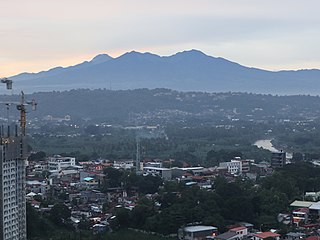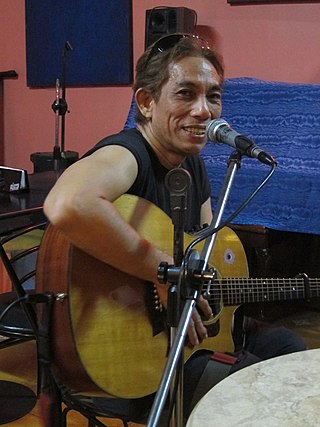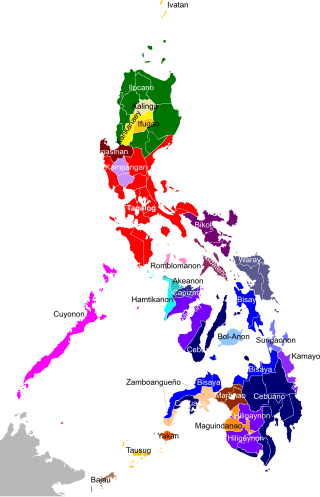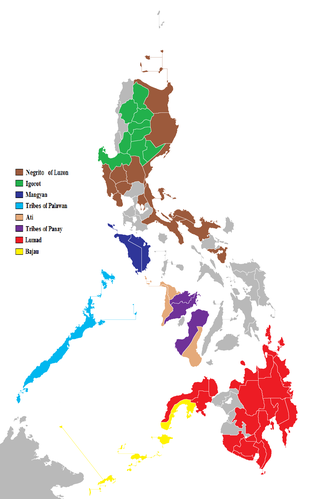Related Research Articles

Bohol, officially the Province of Bohol, is an island province of the Philippines located in the Central Visayas region, consisting of the island itself and 75 minor surrounding islands. Its capital is Tagbilaran. With a land area of 4,821 km2 (1,861 sq mi) and a coastline 261 km (162 mi) long, Bohol is the tenth largest island of the Philippines.

Mount Apo, also known locally as Apo Sandawa, is a large solfataric, dormant stratovolcano on the island of Mindanao, Philippines. With an elevation of 2,954 meters (9,692 ft) above sea level, it is the highest-mountain in the Philippine Archipelago, Mindanao and 24th-highest peak of an island on Earth. Located on the tripartite border of Davao City and Davao del Sur in the Davao Region, and Cotabato in Soccsksargen, Mount Apo is the most-prominent mountain in the Philippines. The peak overlooks from Davao City 45 kilometers (28 mi) to the northeast, Digos 25 kilometers (16 mi) to the southeast, and Kidapawan 20 kilometers (12 mi) to the west. It is a protected area and a Natural Park of the Philippines.

Davao del Sur, officially the Province of Davao del Sur, is a province in the Philippines located in the Davao Region in Mindanao. Its capital is Digos. Davao City is the largest city in terms of area and population within the province's jurisdiction, yet it is administratively independent from the province; as such, Davao City is only grouped for geographical and statistical purposes.

Davao Region, formerly called Southern Mindanao, is an administrative region in the Philippines, designated as Region XI. It is situated at the southeastern portion of Mindanao and comprises five provinces: Davao de Oro, Davao del Norte, Davao del Sur, Davao Oriental, and Davao Occidental.

José Íñigo Homer Lacambra Ayala, professionally known as Joey Ayala, is a Filipino singer, songwriter and former chairman of the music committee of the National Commission for Culture and the Arts. He is well known for his style of music that combines the sounds of Filipino ethnic instruments with modern pop music. His public music life started when he released an album recorded in a makeshift studio in 1982 in Davao City. To date, he has released fourteen albums.

Davao City, officially the City of Davao, is a highly urbanized city in the Davao Region, Philippines. The city has a total land area of 2,443.61 km2 (943.48 sq mi), making it the largest city in the Philippines in terms of land area. It is the third-most populous city in the Philippines after Quezon City and Manila, and the most populous in Mindanao. According to the 2020 census, it has a population of 1,776,949 people.

Kibawe, officially the Municipality of Kibawe, is a 2nd class municipality in the province of Bukidnon, Philippines. According to the 2020 census, it has a population of 41,897 people.

San Fernando, officially the Municipality of San Fernando, is a 1st class municipality in the province of Bukidnon, Philippines. According to the 2020 census, it has a population of 63,045 people.
Datu Sikatuna was a Datu or chieftain of the Bool Kingdom in the island of Bohol in the Philippines. He made a blood compact (sanduguan) and alliance with the Spanish explorer Miguel López de Legazpi on March 25, 1565 at Hinawanan Bay, barangay Hinawanan, Loay. Their blood compact is the first Treaty of Friendship between Spain and the Philippines. The previous site of the pact was thought to have been at barangay Bool, Tagbilaran City but later a panel of historians concluded that the event actually happened at barangay Hinawanan, Loay, Bohol as ratified through Resolution No. 4, issued by the National Historical Institute in 2005.

The Philippines is inhabited by more than 182 ethnolinguistic groups, many of which are classified as "Indigenous Peoples" under the country's Indigenous Peoples' Rights Act of 1997. Traditionally-Muslim peoples from the southernmost island group of Mindanao are usually categorized together as Moro peoples, whether they are classified as Indigenous peoples or not. About 142 are classified as non-Muslim Indigenous people groups, and about 19 ethnolinguistic groups are classified as neither Indigenous nor Moro. Various migrant groups have also had a significant presence throughout the country's history.

The Lumad are a group of Austronesian indigenous peoples in the southern Philippines. It is a Cebuano term meaning "native" or "indigenous". The term is short for Katawhang Lumad, the autonym officially adopted by the delegates of the Lumad Mindanao Peoples Federation (LMPF) founding assembly on 26 June 1986 at the Guadalupe Formation Center, Balindog, Kidapawan, Cotabato, Philippines. Usage of the term was accepted in Philippine jurisprudence when President Corazon Aquino signed into law Republic Act 6734, where the word was used in Art. XIII sec. 8(2) to distinguish Lumad ethnic communities from the islands of Mindanao.

The Legazpi-Sikatuna Blood Compact or Sandugo was a blood compact, performed in the island of Bohol in the Philippines, between the Spanish explorer Miguel López de Legazpi and Datu Sikatuna, chieftain of Bohol, on March 16, 1565, to seal their friendship following tribal tradition. This is considered the first treaty of friendship between the Spaniards and Filipinos. "Sandugo" is a Visayan word which means "one blood".

The Boholano people, also called Bol-anon, refers to the people who live in the island province of Bohol. They are part of the wider Visayan ethnolinguistic group, who constitute the largest Filipino ethnolinguistic group.

The indigenous peoples of the Philippines are ethnolinguistic groups or subgroups that maintain partial isolation or independence throughout the colonial era, and have retained much of their traditional pre-colonial culture and practices.
The Manobo are an indigenous people group from Mindanao in the Philippines, whose core lands cover most of the Mindanao island group, from Sarangani island into the Mindanao mainland in the regions of Agusan, Davao, Bukidnon, Surigao, Misamis, and Cotabato. The Manobo are considered the most diverse among the many indigenous peoples of the Philippines, with the largest number of subgroups within its family of languages. The Philippine Statistics Authority listed 644,904 persons as Manobo in its 2020 Census of Population and Housing.

The Pantaron Mountain Range, also called the Central Cordillera of Mindanao, Philippines straddles across the provinces of Misamis Oriental, Bukidnon, Agusan del Norte, Agusan del Sur, Davao del Norte and Davao del Sur. The range contains one of the last remaining old growth or primary forest blocks in Mindanao. Major rivers on the island also have their headwaters on the mountain range, including Mindanao River, Pulangi River, Davao River, Tagoloan River and major tributaries of Agusan River.
Nepenthes manobo is a tropical pitcher plant endemic in the Philippines discovered in the Pantaron Range on the island of Mindanao, where it grows at a narrow elevation range of 1000–1020 m above sea level.

Eufemia Campos Cullamat, also known as Ka Femia, is a Filipina farmer, activist, and politician. She was a member of the Philippine House of Representatives for the 18th Congress under the Bayan Muna party-list group. She is the second Manobo to serve in Congress after former Cotabato Representative Nancy Catamco.
Lorena Mandacawan is a Matigsalog Manobo activist and spokesperson for the Salugpongan Schools' Parent Teachers Community Association. She also serves as a Barangay Health Worker (BHW), and is the chairperson of Sabokahan. She has spoken against efforts to close Salugpongan schools, against sexual harassment and threats from the military, and against the sexist attitudes propagated by President Duterte.
Tu Pug Imatuy is a 2017 Filipino drama film directed by Arnel Barbarona, produced by Red Motion Media and distributed by Solar Entertainment. The film stars Jong Monzon and Malona Sulatan in lead roles and had its world premiere at the 30th Tokyo International Film Festival on 26 October 2017. Inspired by actual events, the drama tackles the struggle of indigenous Manobos against environment plunder and the militarization of their communities.
References
- 1 2 3 4 5 6 "Lumad Leader Bai Bibyaon Ligkayan Bigkay is 2017 UP Gawad Tandang Sora awardee". University of the Philippines. February 22, 2017. Archived from the original on June 5, 2020. Retrieved June 5, 2020.
- 1 2 3 4 5 Cortez, Kath M. (August 14, 2019). "Lumad women, their inter-generational struggle for self-determination". Davao Today. Archived from the original on November 8, 2020. Retrieved June 5, 2020.
- ↑ Bai Bibyaon Bigkay: Lumad rights advocate, passes away at 90
- ↑ Tan, Michael (March 8, 2017). "Fighting 'lolas'". Philippine Daily Inquirer. Retrieved May 14, 2023.
- 1 2 Salamat, Marya (March 17, 2018). "'We're all challenged to defend the environment' - Bibiaon Bigkay". Bulatlat. Archived from the original on January 17, 2021. Retrieved June 26, 2020.
- ↑ "History of Bohol". www.bohol.gov.ph. Archived from the original on October 3, 2012. Retrieved November 16, 2006.
- ↑ "UP CSWCD names Bai Bibyaon Ligkayan Bigkay 2017 Gawad Tandang Sora honoree". Kodao Productions. February 24, 2017. Archived from the original on December 2, 2020. Retrieved June 5, 2020.
- ↑ Sanvictores, Benito V. Jr. (April 26, 2017). "Bai Bigkay is Gawad Tandang Sora awardee" (Press release). University of the Philippines. Archived from the original on April 3, 2021. Retrieved June 6, 2020.
- ↑ Ramos, Danielle (November 2, 2021). "This book tells the real-life story of Lumad women's fight for their homeland". CNN. Archived from the original on November 2, 2021. Retrieved November 22, 2023.
- ↑ De Dios, Austin (November 8, 2023). "Center for Filipino culture in Portland expands, celebrates with art of "our people"". Oregonian/OregonLive. Retrieved November 22, 2023.